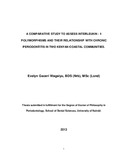| dc.description.abstract | Introduction: Chronic periodontitis (CP) is an infectious disease resulting in the
inflammation of the supportive structures of teeth, which leads to loss of attachment
and bone, and eventually tooth loss if left untreated. Genetic polymorphisms in the
proinflammatory cytokine, interleukin-1 (IL-1A and IL-1B) isoforms have been
associated with CP in Caucasians, Asians and Arabs but little is known about their
role in Africans. Therefore, the aim of this study was to resolve the association
between genetic polymorphisms in IL-1A and IL-1B isoforms and chronic
periodontitis in two Kenyan coastal communities, the Taita and the Swahili.
Objectives: 1) To determine the association between socio-demographic
characteristics, clinical features and CP amongst cases and controls in both ethnic
groups. 2) To determine the severity of CP in both ethnic groups. 3) To determine
the distribution of interleukin-1 genotype polymorphisms of IL-1Band IL-1A in both
ethnic groups. 4) To evaluate the association between IL-1Band IL-1A with CP in
both ethnic groups. 5) To compare the carriage rate of IL-1 polymorphisms amongst
the Taita and Swahili participants.
•
Methodology: This was a population based case-control study. The test was,
whether the marker genotypes distributed differently between the cases and
controls. After informed consent, potential participants were interviewed using a
modified version of the World Health Organization oral health survey questionnaire
for age group 35-44years. A clinical examination was then conducted to assess the
oral health status and data recorded in a data collection form. The presence of
XXlll
dental plaque (PL) using a disclosing agent (produits dentaire vevey, Switzerland)
and bleeding on probing (BOP) were recorded dichotomously. Presence of calculus,
missing teeth and carious teeth were recorded. The examination also included the
measurement of periodontal pocket depths and recession on six sites per tooth.
Buccal swab samples were then obtained as per the manufacturer's instructions
using the isohelix buccal swabs (BocaScientific, Isohelix, Kent, England).
Deoxyribonucleic acid (DNA) was isolated from the swabs using QIAamp DNA
purification protocol followed by polymerase chain reaction (PCR) amplification using
specific primers to IL-1A (loci -889 & +4845) and IL-1B (loci -511 & +3954). The
amplicons were digested using Nc01, Fnu4H1, Ava1 and Taq1 respectively.
Restriction fragment length polymorphisms (RFLP) were recorded after running the
digested amplicons on a 30 % PAGE, followed by visualization under ultra violet
(UV) light after staining with ethidium bromide. Association analyses of the RFLP,
demographic and clinical data were carried out using Pearson's Chi-squared ct)
test and risk was assessed by odds ratios (OR) with 95% confidence interval (CI)J=_2
and Mantel Hanzel tests were used to determine confounders and effect modifiers.
Multivariate analyses were performed. using binary logistic regression. The
genotype frequencies were tested for Hardy-Weinberg equilibrium using theX5-test--=
with one degree of freedom.
Results: Screening was done on approximately 500 individuals at each of the sites.
The number recruited in Taita was 198; 99 cases and 99 controls. 200 were included
in the study from old town Mombasa; 100 cases and 100 controls. The total number
xxiv
of subjects 398 subjects; four loci (-511, -889, +3953 and +4~45) per subject thus
1,592 samples were tested.
The distribution of socio-demographic features amongst the Taita revealed that the
only feature associated with the risk of having chronic periodontitis was being
married with an OR= 2.88(95% CI of 1.12- 7.58) and p=0.014. The mean number of
teeth per individual having plaque in cases was 25(S03.6) and for controls 14(SO
9.9).The difference demonstrated was, OR = 21, with 95% CI = 7.8-56.4, p<0.001.
The mean number of teeth per individual found to be bleeding was 17(SO 10.2).
There was more calculus amongst those with chronic periodontitis OR = 33.9,
95%CI = 13.3-86.3, p<0.001.The mean pocket depth was 1.58(S01.01). 20.7% of
the Taita participants were found to have ~4mm CAL. The severity of CP according
to the COC/AAP classification was as follow: - 10(10.6%) -had mild CP, 43(45.7%)
had moderate CP and 41(43.6%) had the severe form.
No deviation from the Hardy Weinberg equilibrium was observed in any of the
groups. Carriage Of allele 2 at IL-1B +3954 (i.e. combination of '2-2' or'1-2' at locus
+3954) was associated with CP in the Taita participants (OR = 1.94, 95%CI=1.01-
3.70, p=0.045). There were no confounders or effect modifiers in the Taita
participants and no association with severity of CP was observed in this population.
Amongst the male Taita participants, none of them were found to have the
homozygous allele 1 of IL-1A+4845 polymorphism. Amongst the female Taita
participants, the controls had a higher frequency of homozygous allele 1 of ILxxv | en_US |
| dc.description.department | a
Department of Psychiatry, University of Nairobi, ; bDepartment of Mental Health, School of Medicine,
Moi University, Eldoret, Kenya | |

